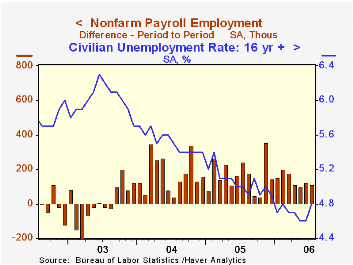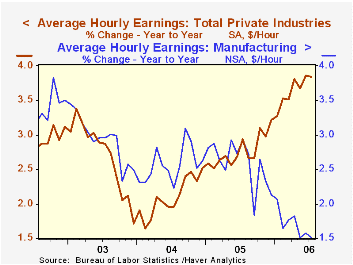 Global| Aug 04 2006
Global| Aug 04 2006U.S. Payrolls & Wages Moderate
by:Tom Moeller
|in:Economy in Brief
Summary
July nonfarm payrolls rose 113,000 and the increase fell short of Consensus expectations for a 142,000 gain. Revisions increased slightly the rise in June payrolls to 124,000 and the rise in May payrolls to 100,000. Year to date [...]

July nonfarm payrolls rose 113,000 and the increase fell short of Consensus expectations for a 142,000 gain. Revisions increased slightly the rise in June payrolls to 124,000 and the rise in May payrolls to 100,000.
Year to date payrolls have risen an average 140,000 per month versus an average of 165,000 last year and an average 175,000 during 2004.
Average hourly earnings rose the same 0.4% as a downwardly revised 0.4% June gain but exceeded expectations for a 0.3% rise. The increase in factory sector earnings moderated to 0.1% (1.5% y/y) from the 0.2% increase in June.
From the household survey the unemployment rate rose to 4.8% versus an expected 4.6%. It was the highest level since February and the increase reflected a 34,000 (+1.6% y/y) decline in employment which followed a 387,000 jump during June. The labor force rose 213,000 (1.3% y/y) as the labor force participation rate remained up at 66.2% though the rate for adult males stayed low at 75.7%. The participation rate for females over 20 rose to a three year high of 60.8%.
The breadth of one month gain in private payrolls fell sharply to 53.2% in July, the lowest since last September. In the factory sector the one month breadth of gain fell to a less-than break even 45.2%.
Factory sector payrolls reversed most of the prior month's gain with a 15,000 decline. Jobs in the computer & electronic products industry fell 8,200 (+0.2% y/y) and the number of motor vehicle & parts jobs fell 7,900 (+0.4% y/y). 
Private service-producing jobs rose 115,000 (1.5% y/y), improved from an upwardly revised 86,000 June increase. Retail trade sector jobs continued weak and were unchanged (-0.6% y/y) after several months of decline. Financial sector jobs rose 6,000 (2.2% y/y) and professional & business services employment rose 43,000 (2.7% y/y). Temporary help services jobs fell for the fifth month this year, by 2,400 (+3.1% y/y). Jobs in education & health services rose 24,000 (2.1% y/y).
Construction employment rose 6,000 (3.0% y/y) following two months of moderate decline. Year to year growth in residential construction jobs moderated further to 2.9% from the peak of 6.0% last year and 7.0% during 2004. Growth in nonresidential construction jobs picked up to 5.5% from 1.7% last year and negative growth in 2004.
The workweek remained elevated at 33.9 hours in private industry versus the 2Q level of 33.9.
Click here for The Unemployment Effects of Proposed Changes in Social Security's "Normal Retirement Age." This paper was published by the National Association for Business Economics (www.nabe.com) in the April 2006 issue of the NABE journal Business Economics.
Participation Dynamics: The More, the Merrier is from the Federal Reserve Bank of St. Louis and it can be found here.
| Employment | July | June | Y/Y | 2005 | 2004 | 2003 |
|---|---|---|---|---|---|---|
| Payroll Employment | 113,000 | 124,000 | 1.3% | 1.5% | 1.1% | -0.3% |
| Manufacturing | -15,000 | 22,000 | 0.1% | -0.6% | -1.3% | -4.9% |
| Average Weekly Hours | 33.9 | 33.9 | 33.8 (July '05) | 33.8 | 33.7 | 33.7 |
| Average Hourly Earnings | 0.4% | 0.4% | 3.8% | 2.8% | 2.1% | 2.7% |
| Unemployment Rate | 4.8% | 4.6% | 5.0% (July '05) | 5.1% | 5.5% | 6.0% |
Tom Moeller
AuthorMore in Author Profile »Prior to joining Haver Analytics in 2000, Mr. Moeller worked as the Economist at Chancellor Capital Management from 1985 to 1999. There, he developed comprehensive economic forecasts and interpreted economic data for equity and fixed income portfolio managers. Also at Chancellor, Mr. Moeller worked as an equity analyst and was responsible for researching and rating companies in the economically sensitive automobile and housing industries for investment in Chancellor’s equity portfolio. Prior to joining Chancellor, Mr. Moeller was an Economist at Citibank from 1979 to 1984. He also analyzed pricing behavior in the metals industry for the Council on Wage and Price Stability in Washington, D.C. In 1999, Mr. Moeller received the award for most accurate forecast from the Forecasters' Club of New York. From 1990 to 1992 he was President of the New York Association for Business Economists. Mr. Moeller earned an M.B.A. in Finance from Fordham University, where he graduated in 1987. He holds a Bachelor of Arts in Economics from George Washington University.






